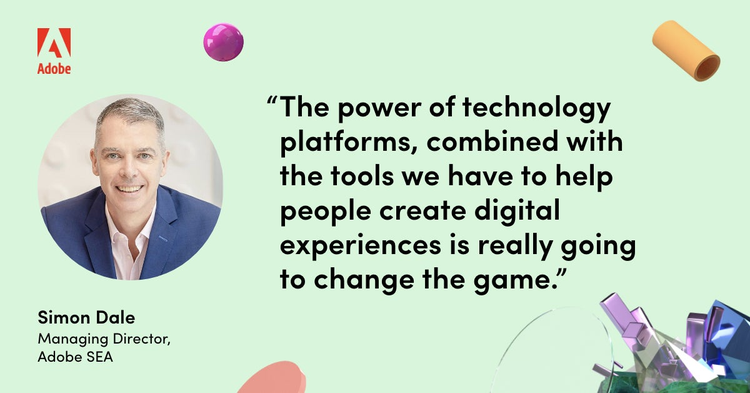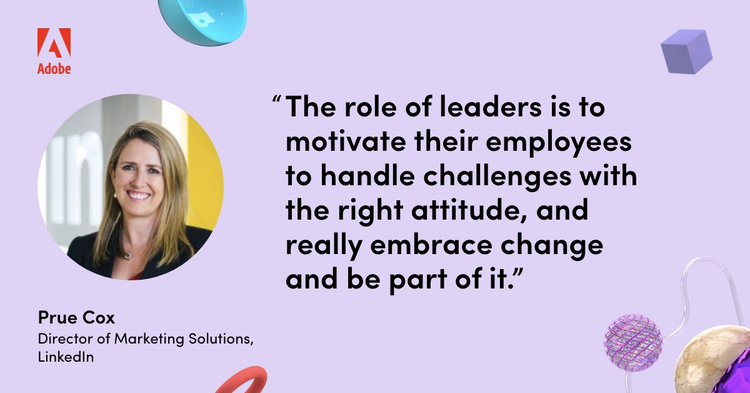This blog is part of our series “Adobe CQ Presents: Making the Modern Leader”.
Technology has the power to augment human skills. But, to harness its full potential, business leaders need to have the right knowledge and understanding of its capabilities.
According to Adobe CQ, just 37 percent of leaders excel in leveraging technology to enhance their team’s creativity. These leaders understand the value of investing in it, and constantly push their teams to explore new tools and solutions to embed within their creative and business processes.
The greatest area of potential for enterprise leaders is in continually assessing creative skills, processes and frameworks, and understanding the gaps and opportunities where tech tools can be used to better support their teams and deliver more engaging experiences.
In the final episode of Adobe CQ Presents: Making the Modern Leader, we chat to Prue Cox, director of marketing solutions at LinkedIn, and Simon Dale, managing director at Adobe Southeast Asia, on marrying up technology and team capabilities to drive creativity. They discuss the role technology plays in creative leadership and how it can be used to boost innovation within teams. Watch the video below and read on to see what they had to say.
https://www.youtube.com/watch?v=x2dEJnYQ2S8
Insight 1: Change management needs to be a competency of leadership today
Technology-related decision making is no longer the domain of the IT department. The C-suite is increasingly leaning into technology and recognising the value and efficiencies it can offer. But for technology to become implemented throughout an organisation, leaders need to create an environment that not only supports their teams through periods of change but encourages them. That begins with understanding how to get teams to break old habits, build new ones, and practice those until they become second nature. “Technology innovation is more than just investing in technology. Leaders need to foster the culture of embracing technology and change being the new norm,” Cox says.
Insight 2: Efficiencies through technology enable improved customer experiences
By automating routine and mundane tasks, technology allows businesses to spend more time developing and refining innovative, personalised customer experiences. At LinkedIn, Cox says technology has been implemented across critical workflows, enabling real-time measurement, continuous optimisation for engagement, AI-driven recommendations for targeting, bidding and more. This has allowed teams to focus on more relevant and creative customer engagement that ultimately drives results. Cox names AI as the most exciting emerging technology, because of how it can be used to augment human skills and revolutionise customer experiences in the near future.
Insight 3: The blurring of lines between marketing and technology will only increase
Both leaders noted a shift away from siloed roles and defined functions within organisations, as well as the rise of novel integrated roles like the chief customer experience officer that crosses both marketing and technology. There is now a renewed focus across businesses on understanding how to improve customer engagement, as well as how this can be enhanced through technology. Dale believes the line between CMOs and CTOs will continue to blur. The latter looks to leverage the CMO’s deep understanding and expertise around how to engage customers when it comes to implementing technology solutions, and vice versa. Dale notes that this convergence will prove powerful in driving businesses forward.
Insight 4: In a hybrid digital-analogue world, leaders need to rethink the skills that matter
As the digitisation of the economy continues to accelerate, creativity will top the list of skills organisations require from employees. The ability to creatively apply—rather than build—technology to the business will be critical. Cox believes leaders must encourage a culture of continuous learning in terms of both technical and soft skills and should invest in training their employees to effectively apply technology in order to connect, inform and engage with stakeholders. Outside their teams, Cox projects that leaders will also pivot towards increased importance placed on trust and privacy, as increased use of emerging technologies means privacy will continue to be a hot-button issue companies must address in order to gain customer confidence.




